Hydrogel-Based Strategies for the Prevention and Treatment of Radiation-Induced Skin Injury: Progress and Mechanistic Insights
Abstract
1. Introduction
1.1. Mechanisms and Clinical Background of RISI
1.2. Hydrogel Carrier Materials and Their Multifaceted Potential
2. Research Progress on the Mechanisms of Hydrogels in RISI
2.1. Natural-Origin and Their Composite Hydrogels
2.1.1. Polysaccharide-Based Materials
2.1.2. Protein-Based Materials
2.1.3. Decellularized Tissue-Based Materials
2.2. Synthetic Polymers and Their Composite Hydrogels
2.3. Hybrid Hydrogels
2.3.1. Cell and Exosome-Based Hybrid Systems
2.3.2. Bioactive Factors and Peptide-Driven Hybrid Systems
2.3.3. Nanoparticle and Inorganic Component-Based Hybrid Systems
2.3.4. Biomimetic and Pathway-Regulated Hybrid Systems
2.4. Smart Hydrogels
3. Conclusions
Author Contributions
Funding
Institutional Review Board Statement
Informed Consent Statement
Data Availability Statement
Conflicts of Interest
Abbreviations
| RISI | Radiation-induced skin injury |
| RT | radiotherapy |
| rhEGF | recombinant human epidermal growth factor |
| ASCs | adipose-derived stem cells |
| MSCs | mesenchymal stem cells |
| HA | Hyaluronic acid |
| DFO | deferoxamine |
| ROS | reactive oxygen species |
| MA | methacrylic anhydride |
| EGCG | epigallocatechin gallate |
| ECM | extracellular matrix |
| ADM | acellular dermal matrix |
| hUCB-MSCs | human umbilical cord blood mesenchymal stem cells |
| WJ-MSCs | Wharton’s jelly-derived MSCs |
| PVA | polyvinyl alcohol |
| PAA | polyacrylic acid |
| PAM | polyacrylamide |
| FA | ferulic acid |
| P-Ac-Lys | polyacryl-lysine |
| GMSCs | gingival mesenchymal stem cells |
| SH | sodium hyaluronate |
| Res | resveratrol |
| PPB | Prussian blue nanoparticles |
| NIR | near-infrared |
| EGF | epidermal growth factor |
References
- Baskar, R.; Lee, K.A.; Yeo, R.; Yeoh, K.-W. Cancer and Radiation Therapy: Current Advances and Future Directions. Int. J. Med. Sci. 2012, 9, 193–199. [Google Scholar] [CrossRef]
- Ryan, J.L. Ionizing Radiation: The Good, the Bad, and the Ugly. J. Investig. Dermatol. 2012, 132, 985–993. [Google Scholar] [CrossRef]
- Hymes, S.R.; Strom, E.A.; Fife, C. Radiation dermatitis: Clinical presentation, pathophysiology, and treatment 2006. J. Am. Acad. Dermatol. 2006, 54, 28–46. [Google Scholar] [CrossRef] [PubMed]
- de Bontempo, P.S.M.; Ciol, M.A.; de Menêses, A.G.; Simino, G.P.R.; Ferreira, E.B.; dos Reis, P.E.D. Acute radiodermatitis in cancer patients: Incidence and severity estimates. Rev. Esc. Enferm. USP 2021, 55, e03676. [Google Scholar] [CrossRef] [PubMed]
- Singh, M.; Alavi, A.; Wong, R.; Akita, S. Radiodermatitis: A Review of Our Current Understanding. Am. J. Clin. Dermatol. 2016, 17, 277–292. [Google Scholar] [CrossRef]
- Seité, S.; Bensadoun, R.-J.; Mazer, J.-M. Prevention and treatment of acute and chronic radiodermatitis. Breast Cancer Targets Ther. 2017, 9, 551–557. [Google Scholar] [CrossRef]
- Xu, Y.; Liu, Q.; Li, W.; Hu, Z.; Shi, C. Recent advances in the mechanisms, current treatment status, and application of multifunctional biomaterials for radiation-induced skin injury. Theranostics 2025, 15, 2700. [Google Scholar] [CrossRef]
- Lierova, A.; Jelicova, M.; Nemcova, M.; Proksova, M.; Pejchal, J.; Zarybnicka, L.; Sinkorova, Z. Cytokines and radiation-induced pulmonary injuries. J. Radiat. Res. 2018, 59, 709–753. [Google Scholar] [CrossRef] [PubMed]
- Choudhury, F.K.; Rivero, R.M.; Blumwald, E.; Mittler, R. Reactive oxygen species, abiotic stress and stress combination. Plant J. 2017, 90, 856–867. [Google Scholar] [CrossRef]
- Sheng, L.; Zhang, Z.; Zhang, Y.; Wang, E.; Ma, B.; Xu, Q.; Ma, L.; Zhang, M.; Pei, G.; Chang, J. A novel “hot spring”-mimetic hydrogel with excellent angiogenic properties for chronic wound healing. Biomaterials 2021, 264, 120414. [Google Scholar] [CrossRef]
- Juhl, P.; Bondesen, S.; Hawkins, C.L.; Karsdal, M.A.; Bay-Jensen, A.-C.; Davies, M.J.; Siebuhr, A.S. Dermal fibroblasts have different extracellular matrix profiles induced by TGF-β, PDGF and IL-6 in a model for skin fibrosis. Sci. Rep. 2020, 10, 17300. [Google Scholar] [CrossRef]
- Martin, P.; Nunan, R. Cellular and molecular mechanisms of repair in acute and chronic wound healing. Br. J. Dermatol. 2015, 173, 370–378. [Google Scholar] [CrossRef]
- Bratborska, A.W.; Gluszak, P.; Joks, M.; Kazmierska, J.; Pazdrowski, J.; Polanska, A.; Jain, S.; Yadav, H.; Masternak, M.M.; Danczak-Pazdrowska, A. Skin Microbiome and Radiation-Induced Skin Injury: Unraveling the Relationship, Mechanisms, and Therapeutic Implications. Int. J. Mol. Sci. 2025, 26, 5022. [Google Scholar] [CrossRef]
- Rübe, C.E.; Freyter, B.M.; Tewary, G.; Roemer, K.; Hecht, M.; Rübe, C. Radiation Dermatitis: Radiation-Induced Effects on the Structural and Immunological Barrier Function of the Epidermis. Int. J. Mol. Sci. 2024, 25, 3320. [Google Scholar] [CrossRef]
- Okunieff, P.; Augustine, E.; Hicks, J.E.; Cornelison, T.L.; Altemus, R.M.; Naydich, B.G.; Ding, I.; Huser, A.K.; Abraham, E.H.; Smith, J.J.; et al. Pentoxifylline in the Treatment of Radiation-Induced Fibrosis. J. Clin. Oncol. 2004, 22, 2207–2213. [Google Scholar] [CrossRef] [PubMed]
- Lee, S.-w.; Moon, S.Y.; Kim, Y.H.; Hong, J.P. The use of recombinant human epidermal growth factor to promote healing for chronic radiation ulcer. Int. Wound J. 2007, 4, 216–220. [Google Scholar] [CrossRef] [PubMed]
- Akita, S.; Yoshimoto, H.; Ohtsuru, A.; Hirano, A.; Yamashita, S. Autologous adipose-derived regenerative cells are effective for chronic intractable radiation injuries. Radiat. Prot. Dosim. 2012, 151, 656–660. [Google Scholar] [CrossRef] [PubMed]
- Finkelstein, S.; Kanee, L.; Behroozian, T.; Wolf, J.R.; van den Hurk, C.; Chow, E.; Bonomo, P. Comparison of clinical practice guidelines on radiation dermatitis: A narrative review. Support. Care Cancer 2022, 30, 4663–4674. [Google Scholar] [CrossRef]
- Behroozian, T.; Goldshtein, D.; Ryan Wolf, J.; van den Hurk, C.; Finkelstein, S.; Lam, H.; Patel, P.; Kanee, L.; Lee, S.F.; Chan, A.W.; et al. MASCC clinical practice guidelines for the prevention and management of acute radiation dermatitis: Part 1) systematic review. eClinicalMedicine 2023, 58, 101886. [Google Scholar] [CrossRef]
- de Menêses, A.G.; dos Reis, P.E.D.; Guerra, E.N.S.; Canto, G.D.L.; Ferreira, E.B. Use of trolamine to prevent and treat acute radiation dermatitis: A systematic review and meta-analysis. Rev. Lat.-Am. Enferm. 2018, 26, e2929. [Google Scholar] [CrossRef]
- Ahmadi, M.; Khalili, H. Potential benefits of pentoxifylline on wound healing. Expert Rev. Clin. Pharmacol. 2016, 9, 129–142. [Google Scholar] [CrossRef]
- Lee, H.J. Therapeutic Potential of the Combination of Pentoxifylline and Vitamin-E in Inflammatory Bowel Disease: Inhibition of Intestinal Fibrosis. J. Clin. Med. 2022, 11, 4713. [Google Scholar] [CrossRef]
- Patel, V.; McGurk, M. Use of pentoxifylline and tocopherol in radiation-induced fibrosis and fibroatrophy. Br. J. Oral Maxillofac. Surg. 2017, 55, 235–241. [Google Scholar] [CrossRef]
- Mirdailami, O.; Soleimani, M.; Dinarvand, R.; Khoshayand, M.R.; Norouzi, M.; Hajarizadeh, A.; Dodel, M.; Atyabi, F. Controlled release of rhEGF and rhbFGF from electrospun scaffolds for skin regeneration. J. Biomed. Mater. Res. Part A 2015, 103, 3374–3385. [Google Scholar] [CrossRef] [PubMed]
- Ryu, S.-H.; Kim, Y.H.; Lee, S.-W.; Hong, J.P. The Preventive Effect of Recombinant Human Growth Factor (rhEGF) on the Recurrence of Radiodermatitis. J. Radiat. Res. 2010, 51, 511–517. [Google Scholar] [CrossRef]
- Lee, S.H.; Jin, S.Y.; Song, J.S.; Seo, K.K.; Cho, K.H. Paracrine effects of adipose-derived stem cells on keratinocytes and dermal fibroblasts. Ann. Dermatol. 2012, 24, 136. [Google Scholar] [CrossRef]
- Rehman, J.; Traktuev, D.; Li, J.; Merfeld-Clauss, S.; Temm-Grove, C.J.; Bovenkerk, J.E.; Pell, C.L.; Johnstone, B.H.; Considine, R.V.; March, K.L. Secretion of Angiogenic and Antiapoptotic Factors by Human Adipose Stromal Cells. Circulation 2004, 109, 1292–1298. [Google Scholar] [CrossRef] [PubMed]
- Si, Z.; Wang, X.; Sun, C.; Kang, Y.; Xu, J.; Wang, X.; Hui, Y. Adipose-derived stem cells: Sources, potency, and implications for regenerative therapies. Biomed. Pharmacother. 2019, 114, 108765. [Google Scholar] [CrossRef] [PubMed]
- Ho, A.Y.; Olm-Shipman, M.; Zhang, Z.; Siu, C.T.; Wilgucki, M.; Phung, A.; Arnold, B.B.; Porinchak, M.; Lacouture, M.; McCormick, B.; et al. A Randomized Trial of Mometasone Furoate 0.1% to Reduce High-Grade Acute Radiation Dermatitis in Breast Cancer Patients Receiving Postmastectomy Radiation. Int. J. Radiat. Oncol. Biol. Phys. 2018, 101, 325–333. [Google Scholar] [CrossRef]
- Hindley, A.; Zain, Z.; Wood, L.; Whitehead, A.; Sanneh, A.; Barber, D.; Hornsby, R. Mometasone Furoate Cream Reduces Acute Radiation Dermatitis in Patients Receiving Breast Radiation Therapy: Results of a Randomized Trial. Int. J. Radiat. Oncol. Biol. Phys. 2014, 90, 748–755. [Google Scholar] [CrossRef]
- Wei, J.; Meng, L.; Hou, X.; Qu, C.; Wang, B.; Xin, Y.; Jiang, X. Radiation-induced skin reactions: Mechanism and treatment. Cancer Manag. Res. 2019, 11, 167–177. [Google Scholar] [CrossRef]
- Boström, Å.; Lindman, H.; Swartling, C.; Berne, B.; Bergh, J. Potent corticosteroid cream (mometasone furoate) significantly reduces acute radiation dermatitis: Results from a double-blind, randomized study. Radiother. Oncol. 2001, 59, 257–265. [Google Scholar] [CrossRef]
- Rosenthal, A.; Israilevich, R.; Moy, R. Management of acute radiation dermatitis: A review of the literature and proposal for treatment algorithm. J. Am. Acad. Dermatol. 2019, 81, 558–567. [Google Scholar] [CrossRef]
- Geara, F.B.; Eid, T.; Zouain, N.; Thebian, R.; Andraos, T.; Chehab, C.; Ramia, P.; Youssef, B.; Zeidan, Y.H. Randomized, Prospective, Open-label Phase III Trial Comparing Mebo Ointment with Biafine Cream for the Management of Acute Dermatitis During Radiotherapy for Breast Cancer. Am. J. Clin. Oncol. 2018, 41, 1257–1262. [Google Scholar] [CrossRef]
- Abbas, H.; Bensadoun, R.-J. Trolamine emulsion for the prevention of radiation dermatitis in patients with squamous cell carcinoma of the head and neck. Support. Care Cancer 2012, 20, 185–190. [Google Scholar] [CrossRef] [PubMed]
- Yang, X.; Ding, Y.; Ji, T.; Zhao, X.; Wang, H.; Zhao, X.; Zhao, R.; Wei, J.; Qi, S.; Nie, G. Improvement of the in vitro safety profile and cytoprotective efficacy of amifostine against chemotherapy by PEGylation strategy. Biochem. Pharmacol. 2016, 108, 11–21. [Google Scholar] [CrossRef] [PubMed]
- King, M.; Joseph, S.; Albert, A.; Thomas, T.V.; Nittala, M.R.; Woods, W.C.; Vijayakumar, S.; Packianathan, S. Use of Amifostine for Cytoprotection during Radiation Therapy: A Review. Oncology 2019, 98, 61–80. [Google Scholar] [CrossRef] [PubMed]
- Nicolay, N.H.; Lopez Perez, R.; Debus, J.; Huber, P.E. Mesenchymal stem cells—A new hope for radiotherapy-induced tissue damage? Cancer Lett. 2015, 366, 133–140. [Google Scholar] [CrossRef] [PubMed]
- Sun, J.; Zhang, Y.; Song, X.; Zhu, J.; Zhu, Q. The Healing Effects of Conditioned Medium Derived from Mesenchymal Stem Cells on Radiation-Induced Skin Wounds in Rats. Cell Transplant. 2019, 28, 105–115. [Google Scholar] [CrossRef]
- Portas, M.; Mansilla, E.; Drago, H.; Dubner, D.; Radl, A.; Coppola, A.; Di Giorgio, M. Use of Human Cadaveric Mesenchymal Stem Cells for Cell Therapy of a Chronic Radiation-Induced Skin Lesion: A Case Report. Radiat. Prot. Dosim. 2016, 171, 99–106. [Google Scholar] [CrossRef]
- Tian, B.; Fu, H.; Liu, B.; Zhu, J.; Zheng, X.; Ge, C. Effects of Amifostine Pre-treatment on miRNA, lncRNA, and mRNA Profiles in the Hypothalamus of Mice Exposed to 60Co Gamma Radiation. Health Phys. 2020, 119, 297–305. [Google Scholar] [CrossRef]
- Ghassemi-Barghi, N.; Etebari, M.; Jafarian-Dehkordi, A. Protective effect of amifostine on busulfan induced DNA damage in human hepatoma cells. Toxicol. Mech. Methods 2017, 27, 52–57. [Google Scholar] [CrossRef]
- Li, J.; Wu, D.-M.; Yu, Y.; Deng, S.-H.; Liu, T.; Zhang, T.; He, M.; Zhao, Y.-Y.; Xu, Y. Amifostine ameliorates induction of experimental autoimmune encephalomyelitis: Effect on reactive oxygen species/NLRP3 pathway. Int. Immunopharmacol. 2020, 88, 106998. [Google Scholar] [CrossRef]
- Stavely, R.; Nurgali, K. The emerging antioxidant paradigm of mesenchymal stem cell therapy. Stem Cells Transl. Med. 2020, 9, 985–1006. [Google Scholar] [CrossRef]
- Ahmed, E.M. Hydrogel: Preparation, characterization, and applications: A review. J. Adv. Res. 2015, 6, 105–121. [Google Scholar] [CrossRef]
- Shan, B.-H.; Wu, F.-G. Hydrogel-Based Growth Factor Delivery Platforms: Strategies and Recent Advances. Adv. Mater. 2024, 36, 2210707. [Google Scholar] [CrossRef]
- Moshaverinia, A.; Chen, C.; Akiyama, K.; Ansari, S.; Xu, X.; Chee, W.W.; Schricker, S.R.; Shi, S. Alginate hydrogel as a promising scaffold for dental-derived stem cells: An in vitro study. J. Mater. Sci. Mater. Med. 2012, 23, 3041–3051. [Google Scholar] [CrossRef] [PubMed]
- Hamidi, M.; Azadi, A.; Rafiei, P. Hydrogel nanoparticles in drug delivery. Adv. Drug Deliv. Rev. 2008, 60, 1638–1649. [Google Scholar] [CrossRef] [PubMed]
- Jiang, S.; Li, H.; Zhang, L.; Mu, W.; Zhang, Y.; Chen, T.; Wu, J.; Tang, H.; Zheng, S.; Liu, Y.; et al. Generic Diagramming Platform (GDP): A comprehensive database of high-quality biomedical graphics. Nucleic Acids Res. 2024, 53, D1670–D1676. [Google Scholar] [CrossRef] [PubMed]
- Gul, K.; Gan, R.-Y.; Sun, C.-X.; Jiao, G.; Wu, D.-T.; Li, H.-B.; Kenaan, A.; Corke, H.; Fang, Y.-P. Recent advances in the structure, synthesis, and applications of natural polymeric hydrogels. Crit. Rev. Food Sci. Nutr. 2022, 62, 3817–3832. [Google Scholar] [CrossRef]
- Liu, X.; Liu, J.; Lin, S.; Zhao, X. Hydrogel machines. Mater. Today 2020, 36, 102–124. [Google Scholar] [CrossRef]
- Sivaraj, D.; Chen, K.; Chattopadhyay, A.; Henn, D.; Wu, W.; Noishiki, C.; Magbual, N.J.; Mittal, S.; Mermin-Bunnell, A.M.; Bonham, C.A. Hydrogel scaffolds to deliver cell therapies for wound healing. Front. Bioeng. Biotechnol. 2021, 9, 2296–4185. [Google Scholar] [CrossRef]
- Wang, J.; Gao, L.; Song, J.; Li, S. Study of EGCG composite hydrogel for the treatment of radiation-induced skin injuries. J. Appl. Biomater. Funct. Mater. 2023, 21, 2280–8000. [Google Scholar] [CrossRef]
- Elkhoury, K.; Morsink, M.; Sanchez-Gonzalez, L.; Kahn, C.; Tamayol, A.; Arab-Tehrany, E. Biofabrication of natural hydrogels for cardiac, neural, and bone Tissue engineering Applications. Bioact. Mater. 2021, 6, 3904–3923. [Google Scholar] [CrossRef] [PubMed]
- Cruz-Acuna, R.; García, A.J. Synthetic hydrogels mimicking basement membrane matrices to promote cell-matrix interactions. Matrix Biol. 2017, 57, 324–333. [Google Scholar] [CrossRef]
- Kolipaka, T.; Pandey, G.; Abraham, N.; Srinivasarao, D.A.; Raghuvanshi, R.S.; Rajinikanth, P.; Tickoo, V.; Srivastava, S. Stimuli-responsive polysaccharide-based smart hydrogels for diabetic wound healing: Design aspects, preparation methods and regulatory perspectives. Carbohydr. Polym. 2024, 324, 121537. [Google Scholar] [CrossRef]
- Liang, Y.; He, J.; Guo, B. Functional Hydrogels as Wound Dressing to Enhance Wound Healing. ACS Nano 2021, 15, 12687–12722. [Google Scholar] [CrossRef] [PubMed]
- Catoira, M.C.; Fusaro, L.; Di Francesco, D.; Ramella, M.; Boccafoschi, F. Overview of natural hydrogels for regenerative medicine applications. J. Mater. Sci. Mater. Med. 2019, 30, 115. [Google Scholar] [CrossRef]
- Sepe, F.; Valentino, A.; Marcolongo, L.; Petillo, O.; Calarco, A.; Margarucci, S.; Peluso, G.; Conte, R. Polysaccharide Hydrogels as Delivery Platforms for Natural Bioactive Molecules: From Tissue Regeneration to Infection Control. Gels 2025, 11, 198. [Google Scholar] [CrossRef]
- Oh, S.H.; An, D.B.; Kim, T.H.; Lee, J.H. Wide-range stiffness gradient PVA/HA hydrogel to investigate stem cell differentiation behavior. Acta Biomater. 2016, 35, 23–31. [Google Scholar] [CrossRef] [PubMed]
- Lam, J.; Truong, N.F.; Segura, T. Design of cell–matrix interactions in hyaluronic acid hydrogel scaffolds. Acta Biomater. 2014, 10, 1571–1580. [Google Scholar] [CrossRef] [PubMed]
- Highley, C.B.; Prestwich, G.D.; Burdick, J.A. Recent advances in hyaluronic acid hydrogels for biomedical applications. Curr. Opin. Biotechnol. 2016, 40, 35–40. [Google Scholar] [CrossRef]
- Dattilo, M.; Patitucci, F.; Prete, S.; Parisi, O.I.; Puoci, F. Polysaccharide-Based Hydrogels and Their Application as Drug Delivery Systems in Cancer Treatment: A Review. J. Funct. Biomater. 2023, 14, 55. [Google Scholar] [CrossRef] [PubMed]
- Zhang, M.; Zhao, X. Alginate hydrogel dressings for advanced wound management. Int. J. Biol. Macromol. 2020, 162, 1414–1428. [Google Scholar] [CrossRef] [PubMed]
- Abka-khajouei, R.; Tounsi, L.; Shahabi, N.; Patel, A.K.; Abdelkafi, S.; Michaud, P. Structures, Properties and Applications of Alginates. Mar. Drugs 2022, 20, 364. [Google Scholar] [CrossRef]
- Pereira, R.; Carvalho, A.; Vaz, D.C.; Gil, M.H.; Mendes, A.; Bártolo, P. Development of novel alginate based hydrogel films for wound healing applications. Int. J. Biol. Macromol. 2013, 52, 221–230. [Google Scholar] [CrossRef]
- Giri, T.K.; Thakur, D.; Alexander, A.; Ajazuddin; Badwaik, H.; Tripathi, D.K. Alginate based hydrogel as a potential biopolymeric carrier for drug delivery and cell delivery systems: Present status and applications. Curr. Drug Deliv. 2012, 9, 539–555. [Google Scholar] [CrossRef]
- Younes, I.; Rinaudo, M. Chitin and Chitosan Preparation from Marine Sources. Structure, Properties and Applications. Mar. Drugs 2015, 13, 1133–1174. [Google Scholar] [CrossRef]
- Ribeiro, M.P.; Espiga, A.; Silva, D.; Baptista, P.; Henriques, J.; Ferreira, C.; Silva, J.C.; Borges, J.P.; Pires, E.; Chaves, P.; et al. Development of a new chitosan hydrogel for wound dressing. Wound Repair. Regen. 2009, 17, 817–824. [Google Scholar] [CrossRef] [PubMed]
- Pellá, M.C.G.; Lima-Tenório, M.K.; Tenório-Neto, E.T.; Guilherme, M.R.; Muniz, E.C.; Rubira, A.F. Chitosan-based hydrogels: From preparation to biomedical applications. Carbohydr. Polym. 2018, 196, 233–245. [Google Scholar] [CrossRef]
- Fu, J.; Yang, F.; Guo, Z. The chitosan hydrogels: From structure to function. New J. Chem. 2018, 42, 17162–17180. [Google Scholar] [CrossRef]
- Bhattarai, N.; Gunn, J.; Zhang, M. Chitosan-based hydrogels for controlled, localized drug delivery. Adv. Drug Deliv. Rev. 2010, 62, 83–99. [Google Scholar] [CrossRef] [PubMed]
- Tian, X.; Guo, J.; Gu, C.; Wang, H.; Wang, D.; Liao, Y.; Zhu, S.; Zhao, M.; Gu, Z. Ergothioneine-Sodium Hyaluronate Dressing: A Promising Approach for Protecting against Radiation-Induced Skin Injury. ACS Appl. Mater. Interfaces 2024, 16, 29917–29929. [Google Scholar] [CrossRef] [PubMed]
- Gao, S.; Zheng, T.; Tian, K.; Jia, Z.; Xu, W.; Wu, P.; Cao, S.; Li, K.; Wu, L. Application of Physically Crosslinked Hyaluronic Acid Hydrogel in the Treatment of Radiation-Induced Skin Injury. Adv. Ther. 2024, 7, 2400165. [Google Scholar] [CrossRef]
- Kang, J.I.; Park, K.M.; Park, K.D. Oxygen-generating alginate hydrogels as a bioactive acellular matrix for facilitating wound healing. J. Ind. Eng. Chem. 2019, 69, 397–404. [Google Scholar] [CrossRef]
- Cao, Y.; Zhu, C.; Zhu, H.; Chen, X.; Luo, H. Observation of the Therapeutic Effect of Hydrogel Combined with Alginate Dressings for a Patient with Grade 4 Acute Radiation Dermatitis: A Case Report. Adv. Skin Wound Care 2024, 37, 1–5. [Google Scholar] [CrossRef]
- Luo, X.; Liu, H.; Wen, J.; Hu, J.; Li, Y.; Li, G.; Dai, G.; Li, Y.; Li, J. Composite hydrogels with antioxidant and robust adhesive properties for the prevention of radiation-induced dermatitis. J. Mater. Chem. B 2024, 12, 6927–6939. [Google Scholar] [CrossRef]
- Hao, J.; Sun, M.; Li, D.; Zhang, T.; Li, J.; Zhou, D. An IFI6-based hydrogel promotes the healing of radiation-induced skin injury through regulation of the HSF1 activity. J. Nanobiotechnol. 2022, 20, 288. [Google Scholar] [CrossRef]
- Cui, F.-M.; Wu, Z.-J.; Zhao, R.; Chen, Q.; Liu, Z.-Y.; Zhao, Y.; Yan, H.-B.; Shen, G.-L.; Tu, Y.; Zhou, D.-H.; et al. Development and Characterization of a Novel Hydrogel for the Decontaminating of Radionuclide-Contaminated Skin Wounds. Macromol. Biosci. 2021, 21, 2000399. [Google Scholar] [CrossRef]
- He, X.; Hu, X.; Dong, X.; Li, S.; Ni, Y. Application and clinical efficacy of Sufu medical chitosan hydrogel dressing in radiation skin damage caused by radiotherapy for cervical cancer. Pak. J. Med. Sci. 2022, 38, 2331. [Google Scholar] [CrossRef]
- Shen, J.; Jiao, W.; Chen, Z.; Wang, C.; Song, X.; Ma, L.; Tang, Z.; Yan, W.; Xie, H.; Yuan, B.; et al. Injectable multifunctional chitosan/dextran-based hydrogel accelerates wound healing in combined radiation and burn injury. Carbohydr. Polym. 2023, 316, 121024. [Google Scholar] [CrossRef]
- Zhou, W.; Zhu, L.; Zu, X.; Ma, Y.; Shen, P.; Hu, Y.; Zhang, P.; Ni, Z.; Wang, N.; Sun, D. A novel antioxidant and anti-inflammatory carboxymethylcellulose/chitosan hydrogel loaded with cannabidiol promotes the healing of radiation-combined wound skin injury in the 60Co γ-irradiated mice. Phytomedicine 2025, 142, 156790. [Google Scholar] [CrossRef]
- Zhang, J.; Zhu, Y.; Zhang, Y.; Lin, W.; Ke, J.; Liu, J.; Zhang, L.; Liu, J. A balanced charged hydrogel with anti-biofouling and antioxidant properties for treatment of irradiation-induced skin injury. Mater. Sci. Eng. C 2021, 131, 112538. [Google Scholar] [CrossRef] [PubMed]
- Katona, G.; Sipos, B.; Csóka, I. Advancements in the Field of Protein-Based Hydrogels: Main Types, Characteristics, and Their Applications. Gels 2025, 11, 306. [Google Scholar] [CrossRef] [PubMed]
- Qin, J.; Chen, F.; Wu, P.; Sun, G. Recent Advances in Bioengineered Scaffolds for Cutaneous Wound Healing. Front. Bioeng. Biotechnol. 2022, 10, 841583. [Google Scholar] [CrossRef]
- Jaipan, P.; Nguyen, A.; Narayan, R.J. Gelatin-based hydrogels for biomedical applications. MRS Commun. 2017, 7, 416–426. [Google Scholar] [CrossRef]
- Milano, F.; Masi, A.; Madaghiele, M.; Sannino, A.; Salvatore, L.; Gallo, N. Current Trends in Gelatin-Based Drug Delivery Systems. Pharmaceutics 2023, 15, 1499. [Google Scholar] [CrossRef]
- Yue, K.; Trujillo-de Santiago, G.; Alvarez, M.M.; Tamayol, A.; Annabi, N.; Khademhosseini, A. Synthesis, properties, and biomedical applications of gelatin methacryloyl (GelMA) hydrogels. Biomaterials 2015, 73, 254–271. [Google Scholar] [CrossRef]
- Kang, J.I.; Park, K.M. Advances in gelatin-based hydrogels for wound management. J. Mater. Chem. B 2021, 9, 1503–1520. [Google Scholar] [CrossRef] [PubMed]
- Andreazza, R.; Morales, A.; Pieniz, S.; Labidi, J. Gelatin-Based Hydrogels: Potential Biomaterials for Remediation. Polymers 2023, 15, 1026. [Google Scholar] [CrossRef]
- Zheng, H.; Zuo, B. Functional silk fibroin hydrogels: Preparation, properties and applications. J. Mater. Chem. B 2021, 9, 1238–1258. [Google Scholar] [CrossRef]
- Zhang, H.; Xu, D.; Zhang, Y.; Li, M.; Chai, R. Silk fibroin hydrogels for biomedical applications. Smart Med. 2022, 1, e20220011. [Google Scholar] [CrossRef]
- Kim, U.-J.; Park, J.; Li, C.; Jin, H.-J.; Valluzzi, R.; Kaplan, D.L. Structure and Properties of Silk Hydrogels. Biomacromolecules 2004, 5, 786–792. [Google Scholar] [CrossRef]
- Nguyen, T.P.; Nguyen, Q.V.; Nguyen, V.-H.; Le, T.-H.; Huynh, V.Q.N.; Vo, D.-V.N.; Trinh, Q.T.; Kim, S.Y.; Le, Q.V. Silk Fibroin-Based Biomaterials for Biomedical Applications: A Review. Polymers 2019, 11, 1933. [Google Scholar] [CrossRef]
- Zhang, Y.; Wang, Y.; Li, Y.; Yang, Y.; Jin, M.; Lin, X.; Zhuang, Z.; Guo, K.; Zhang, T.; Tan, W. Application of Collagen-Based Hydrogel in Skin Wound Healing. Gels 2023, 9, 185. [Google Scholar] [CrossRef]
- Sargeant, T.D.; Desai, A.P.; Banerjee, S.; Agawu, A.; Stopek, J.B. An in situ forming collagen–PEG hydrogel for tissue regeneration. Acta Biomater. 2012, 8, 124–132. [Google Scholar] [CrossRef] [PubMed]
- Helary, C.; Bataille, I.; Abed, A.; Illoul, C.; Anglo, A.; Louedec, L.; Letourneur, D.; Meddahi-Pellé, A.; Giraud-Guille, M.M. Concentrated collagen hydrogels as dermal substitutes. Biomaterials 2010, 31, 481–490. [Google Scholar] [CrossRef]
- Antoine, E.E.; Vlachos, P.P.; Rylander, M.N. Review of Collagen I Hydrogels for Bioengineered Tissue Microenvironments: Characterization of Mechanics, Structure, and Transport. Tissue Eng. Part B Rev. 2014, 20, 683–696. [Google Scholar] [CrossRef] [PubMed]
- Huang, X.; Zhang, Y.; Zhang, X.; Xu, L.; Chen, X.; Wei, S. Influence of radiation crosslinked carboxymethyl-chitosan/gelatin hydrogel on cutaneous wound healing. Mater. Sci. Eng. C 2013, 33, 4816–4824. [Google Scholar] [CrossRef]
- Ma, D.; Wang, Y.; Dai, W. Silk fibroin-based biomaterials for musculoskeletal tissue engineering. Mater. Sci. Eng. C 2018, 89, 456–469. [Google Scholar] [CrossRef] [PubMed]
- Zhang, Z.; Cao, Q.; Xia, Y.; Cui, C.; Qi, Y.; Zhang, Q.; Wu, Y.; Liu, J.; Liu, W. Combination of biodegradable hydrogel and antioxidant bioadhesive for treatment of breast cancer recurrence and radiation skin injury. Bioact. Mater. 2024, 31, 408–421. [Google Scholar] [CrossRef]
- Liu, Y.; Qin, D.; Wang, H.; Zhu, Y.; Bi, S.; Liu, Y.; Cheng, X.; Chen, X. Effect and mechanism of fish scale extract natural hydrogel on skin protection and cell damage repair after UV irradiation. Colloids Surf. B. Biointerfaces 2023, 225, 113281. [Google Scholar] [CrossRef]
- Liu, X.; Guo, T.; Huang, Z.; Chen, S.; Chen, L.; Li, C.; Tian, T.; Qian, Y.; Yang, L.; Xiang, J. Acellular dermal matrix hydrogels promote healing of radiation-induced skin injury in a rat model. J. Mater. Chem. B 2024, 12, 11218–11229. [Google Scholar] [CrossRef]
- Lee, C.; Shim, S.; Jang, H.; Myung, H.; Lee, J.; Bae, C.-H.; Myung, J.K.; Kim, M.-J.; Lee, S.B.; Jang, W.-S. Human umbilical cord blood–derived mesenchymal stromal cells and small intestinal submucosa hydrogel composite promotes combined radiation-wound healing of mice. Cytotherapy 2017, 19, 1048–1059. [Google Scholar] [CrossRef] [PubMed]
- Xiang, K.; Chen, J.; Guo, J.; Li, G.; Kang, Y.; Wang, C.; Jiang, T.; Zhang, M.; Jiang, G.; Yuan, M.; et al. Multifunctional ADM hydrogel containing endothelial cell-exosomes for diabetic wound healing. Mater. Today Bio 2023, 23, 100863. [Google Scholar] [CrossRef] [PubMed]
- DeCostanza, L.; Grogan, G.M.; Bruce, A.C.; Peachey, C.M.; Clark, E.A.; Atkins, K.; Tylek, T.; Solga, M.D.; Spiller, K.L.; Peirce, S.M.; et al. Decellularized porcine dermal hydrogel enhances implant-based wound healing in the setting of irradiation. Acta Biomater. 2025, 191, 260–275. [Google Scholar] [CrossRef] [PubMed]
- Avadanei-Luca, S.; Nacu, I.; Avadanei, A.N.; Pertea, M.; Tamba, B.; Verestiuc, L.; Scripcariu, V. Tissue Regeneration of Radiation-Induced Skin Damages Using Protein/Polysaccharide-Based Bioengineered Scaffolds and Adipose-Derived Stem Cells: A Review. Int. J. Mol. Sci. 2025, 26, 6469. [Google Scholar] [CrossRef]
- Hao, Y.; Li, H.; Guo, J.; Wang, D.; Zhang, J.; Liu, J.; Yang, C.; Zhang, Y.; Li, G.; Liu, J. Bio-inspired antioxidant heparin-mimetic peptide hydrogel for radiation-induced skin injury repair. Adv. Healthc. Mater. 2023, 12, 2203387. [Google Scholar] [CrossRef]
- Zhong, Y.; Lin, Q.; Yu, H.; Shao, L.; Cui, X.; Pang, Q.; Zhu, Y.; Hou, R. Construction methods and biomedical applications of PVA-based hydrogels. Front. Chem. 2024, 12, 1376799. [Google Scholar] [CrossRef]
- Kamoun, E.A.; Kenawy, E.-R.S.; Chen, X. A review on polymeric hydrogel membranes for wound dressing applications: PVA-based hydrogel dressings. J. Adv. Res. 2017, 8, 217–233. [Google Scholar] [CrossRef]
- Jiang, S.; Liu, S.; Feng, W. PVA hydrogel properties for biomedical application. J. Mech. Behav. Biomed. Mater. 2011, 4, 1228–1233. [Google Scholar] [CrossRef]
- Wang, L.; Duan, L.; Liu, G.; Sun, J.; Shahbazi, M.-A.; Kundu, S.C.; Reis, R.L.; Xiao, B.; Yang, X. Bioinspired Polyacrylic Acid-Based Dressing: Wet Adhesive, Self-Healing, and Multi-Biofunctional Coacervate Hydrogel Accelerates Wound Healing. Adv. Sci. 2023, 10, 2207352. [Google Scholar] [CrossRef] [PubMed]
- Dong, Y.; Su, J.; Guo, X.; Zhang, Q.; Zhu, S.; Zhang, K.; Zhu, H. Multifunctional protocatechuic acid–polyacrylic acid hydrogel adhesives for wound dressings. J. Mater. Chem. B 2024, 12, 6617–6626. [Google Scholar] [CrossRef]
- Chen, L.; Qin, Y.; Cheng, J.; Cheng, Y.; Lu, Z.; Liu, X.; Yang, S.; Lu, S.; Zheng, L.; Cao, Q. A biocompatible PAA-Cu-MOP hydrogel for wound healing. RSC Adv. 2020, 10, 36212–36218. [Google Scholar] [CrossRef]
- Chen, K.; Liu, J.; Yang, X.; Zhang, D. Preparation, optimization and property of PVA-HA/PAA composite hydrogel. Mater. Sci. Eng. C 2017, 78, 520–529. [Google Scholar] [CrossRef] [PubMed]
- Huang, C.; Huangfu, C.; Bai, Z.; Zhu, L.; Shen, P.; Wang, N.; Li, G.; Deng, H.; Ma, Z.; Zhou, W.; et al. Multifunctional carbomer based ferulic acid hydrogel promotes wound healing in radiation-induced skin injury by inactivating NLRP3 inflammasome. J. Nanobiotechnol. 2024, 22, 576. [Google Scholar] [CrossRef]
- Kulshrestha, S.; Chawla, R.; Singh, S.; Yadav, P.; Sharma, N.; Goel, R.; Ojha, H.; Kumar, V.; Adhikari, J. Protection of sildenafil citrate hydrogel against radiation-induced skin wounds. Burns 2020, 46, 1157–1169. [Google Scholar] [CrossRef]
- Liu, M.; Yu, W.; Fang, Y.; Zhou, H.; Liang, Y.; Huang, C.; Liu, H.; Zhao, G. Pyruvate and lactate based hydrogel film inhibits UV radiation-induced skin inflammation and oxidative stress. Int. J. Pharm. 2023, 634, 122697. [Google Scholar] [CrossRef]
- Zheng, K.; Tong, Y.; Zhang, S.; He, R.; Xiao, L.; Iqbal, Z.; Zhang, Y.; Gao, J.; Zhang, L.; Jiang, L.; et al. Flexible Bicolorimetric Polyacrylamide/Chitosan Hydrogels for Smart Real-Time Monitoring and Promotion of Wound Healing. Adv. Funct. Mater. 2021, 31, 2102599. [Google Scholar] [CrossRef]
- Su, Y.; Xu, J.; Liu, W.; Shu, Y.; Ma, H.; Cheng, Y.Y.; Liu, Y.; Pan, B.; Song, K. A gelatin/acrylamide-based hydrogel for smart drug release monitoring and radiation-induced wound repair in breast cancer. Int. J. Biol. Macromol. 2024, 283, 137845. [Google Scholar] [CrossRef] [PubMed]
- Jiang, F.; Chi, Z.; Ding, Y.; Quan, M.; Tian, Y.; Shi, J.; Song, F.; Liu, C. Wound Dressing Hydrogel of Enteromorpha prolifera Polysaccharide–Polyacrylamide Composite: A Facile Transformation of Marine Blooming into Biomedical Material. ACS Appl. Mater. Interfaces 2021, 13, 14530–14542. [Google Scholar] [CrossRef] [PubMed]
- Xu, X.; Chen, Y.; Song, Q.; Yuan, L.; Gu, J.; Zhang, L.; Geng, J.; Dong, J. Human Placenta–Derived Mesenchymal Stem Cell Hydrogel Promotes the Healing of Radiation-Induced Skin Injury in SD Rats. Chin. J. Tissue Eng. Res. 2021, 25, 3976–3980. [Google Scholar] [CrossRef]
- Nie, S.; Ren, C.; Cai, H.; Sun, H.; Liu, F.; Du, L.; Wang, Q.; Xu, C.; Liu, Y.; He, N. The protective effect of gingival mesenchymal stem cells on radiation-induced skin damage and its mechanism. Res. Sq. 2022. [Google Scholar] [CrossRef]
- Fang, Z.; Lv, Y.; Zhang, H.; He, Y.; Gao, H.; Chen, C.; Wang, D.; Chen, P.; Tang, S.; Li, J.; et al. A multifunctional hydrogel loaded with two nanoagents improves the pathological microenvironment associated with radiation combined with skin wounds. Acta Biomater. 2023, 159, 111–127. [Google Scholar] [CrossRef]
- Park, S.J.; Cho, W.; Kim, M.S.; Gu, B.K.; Kang, C.M.; Khang, G.; Kim, C.-H. Substance-P and transforming growth factor-β in chitosan microparticle-pluronic hydrogel accelerates regenerative wound repair of skin injury by local ionizing radiation. J. Tissue Eng. Regen. Med. 2018, 12, 890–896. [Google Scholar] [CrossRef]
- Marchiori, M.C.L.; Rigon, C.; Camponogara, C.; Oliveira, S.M.; Cruz, L. Hydrogel containing silibinin-loaded pomegranate oil based nanocapsules exhibits anti-inflammatory effects on skin damage UVB radiation-induced in mice. J. Photochem. Photobiol. B Biol. 2017, 170, 25–32. [Google Scholar] [CrossRef] [PubMed]
- Xie, J.; Zhao, M.; Wang, C.; Zhu, S.; Niu, W.; Yong, Y.; Zhao, L.; Gu, Z. External use of Nano-graphdiyne hydrogel for skin radioprotection via both physically shielding of Low-energy X-ray and chemically scavenging of Broad-spectrum free radicals. Chem. Eng. J. 2022, 430, 132866. [Google Scholar] [CrossRef]
- Shen, J.; Jiao, W.; Yang, J.; Zhuang, B.; Du, S.; Wu, Y.; Huang, G.; Zhang, Y.; Wang, Y.; Xu, C.; et al. In situ photocrosslinkable hydrogel treats radiation-induced skin injury by ROS elimination and inflammation regulation. Biomaterials 2025, 314, 122891. [Google Scholar] [CrossRef]
- Huang, R.; Sun, W.; Li, W.; Hu, R.; Meng, R.; Peng, Z.; Yang, R.; Huang, T.; Du, J.; Shang, L. Immunomodulatory hydrogel patches loaded with curcumin and tannic acid assembled nanoparticles for radiation dermatitis repair and radioprotection. Chem. Eng. J. 2024, 500, 156869. [Google Scholar] [CrossRef]
- Guo, J.; Zhang, X.; Mao, R.; Li, H.; Hao, Y.; Zhang, J.; Wang, W.; Zhang, Y.; Liu, J. Multifunctional Glycopeptide-Based Hydrogel via Dual-Modulation for the Prevention and Repair of Radiation-Induced Skin Injury. ACS Biomater. Sci. Eng. 2024, 10, 5168–5180. [Google Scholar] [CrossRef]
- Feng, Z.; Zhang, Y.; Yang, C.; Liu, X.; Huangfu, Y.; Zhang, C.; Huang, P.; Dong, A.; Liu, J.; Liu, J. Bioinspired and inflammation-modulatory glycopeptide hydrogels for radiation-induced chronic skin injury repair. Adv. Healthc. Mater. 2023, 12, 2201671. [Google Scholar] [CrossRef]
- Munteanu, C.; Prifti, E.; Surd, A.; Mârza, S.M. Tailoring Therapy: Hydrogels as Tunable Platforms for Regenerative Medicine and Cancer Intervention. Gels 2025, 11, 679. [Google Scholar] [CrossRef]
- Bordbar-Khiabani, A.; Gasik, M. Smart Hydrogels for Advanced Drug Delivery Systems. Int. J. Mol. Sci. 2022, 23, 3665. [Google Scholar] [CrossRef] [PubMed]
- Zhou, D.; Li, Z.; Bao, L.; Zhao, X.; Hao, J.; Xu, C.; Sun, F.; He, D.; Jiang, C.; Zeng, T.; et al. DNAzyme hydrogels specifically inhibit the NLRP3 pathway to prevent radiation-induced skin injury in mice. J. Nanobiotechnol. 2025, 23, 238. [Google Scholar] [CrossRef] [PubMed]
- Xia, Y.; Gui, H.; Li, X.; Wu, Y.; Liu, J.; Liu, J. X-ray Responsive Antioxidant Drug-Free Hydrogel for Treatment of Radiation Skin Injury. ACS Appl. Mater. Interfaces 2025, 17, 5671–5683. [Google Scholar] [CrossRef] [PubMed]
- Srinivas, A.; Ramamurthi, A. Effects of Gamma-Irradiation on Physical and Biologic Properties of Crosslinked Hyaluronan Tissue Engineering Scaffolds. Tissue Eng. 2007, 13, 447–459. [Google Scholar] [CrossRef]

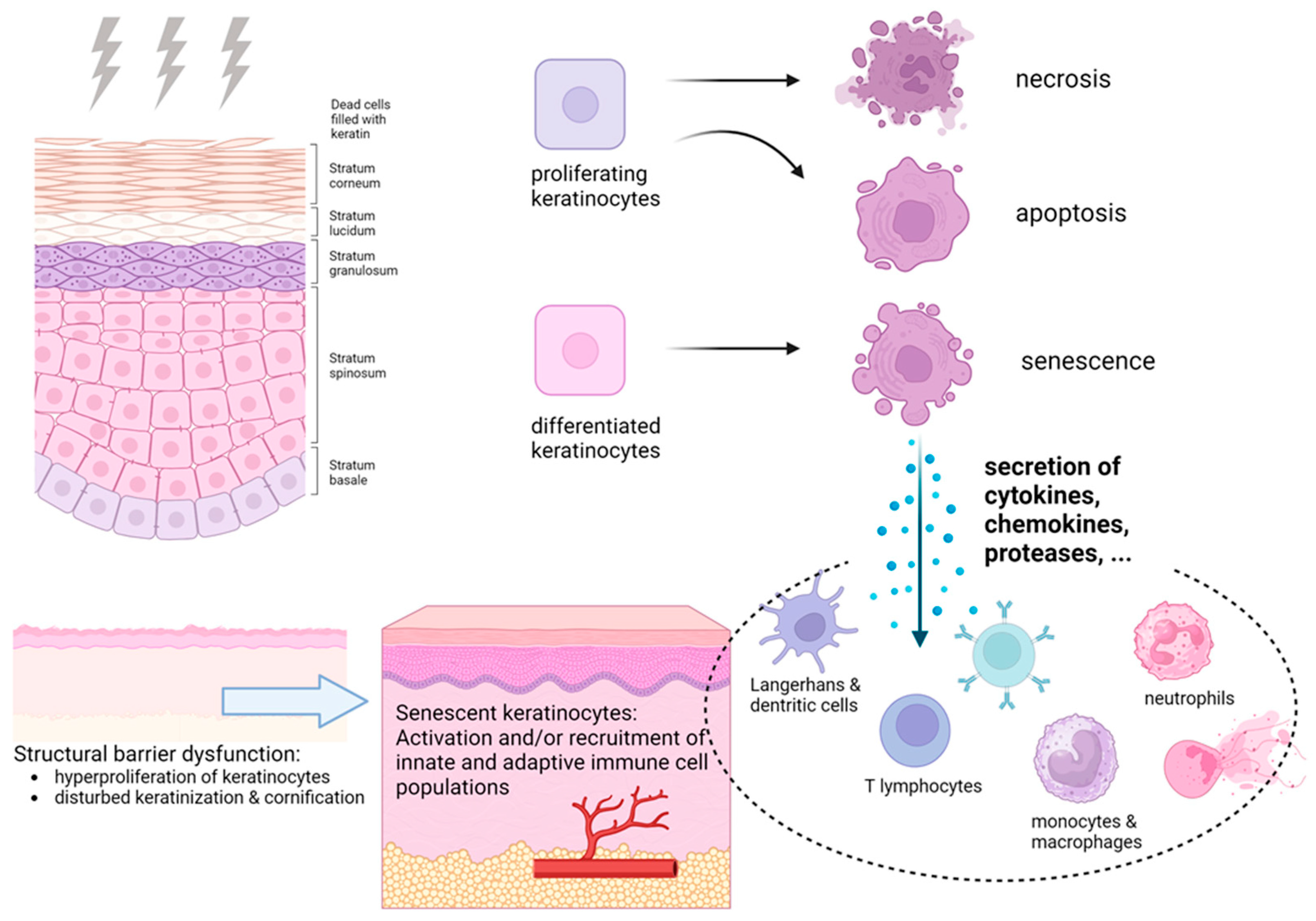
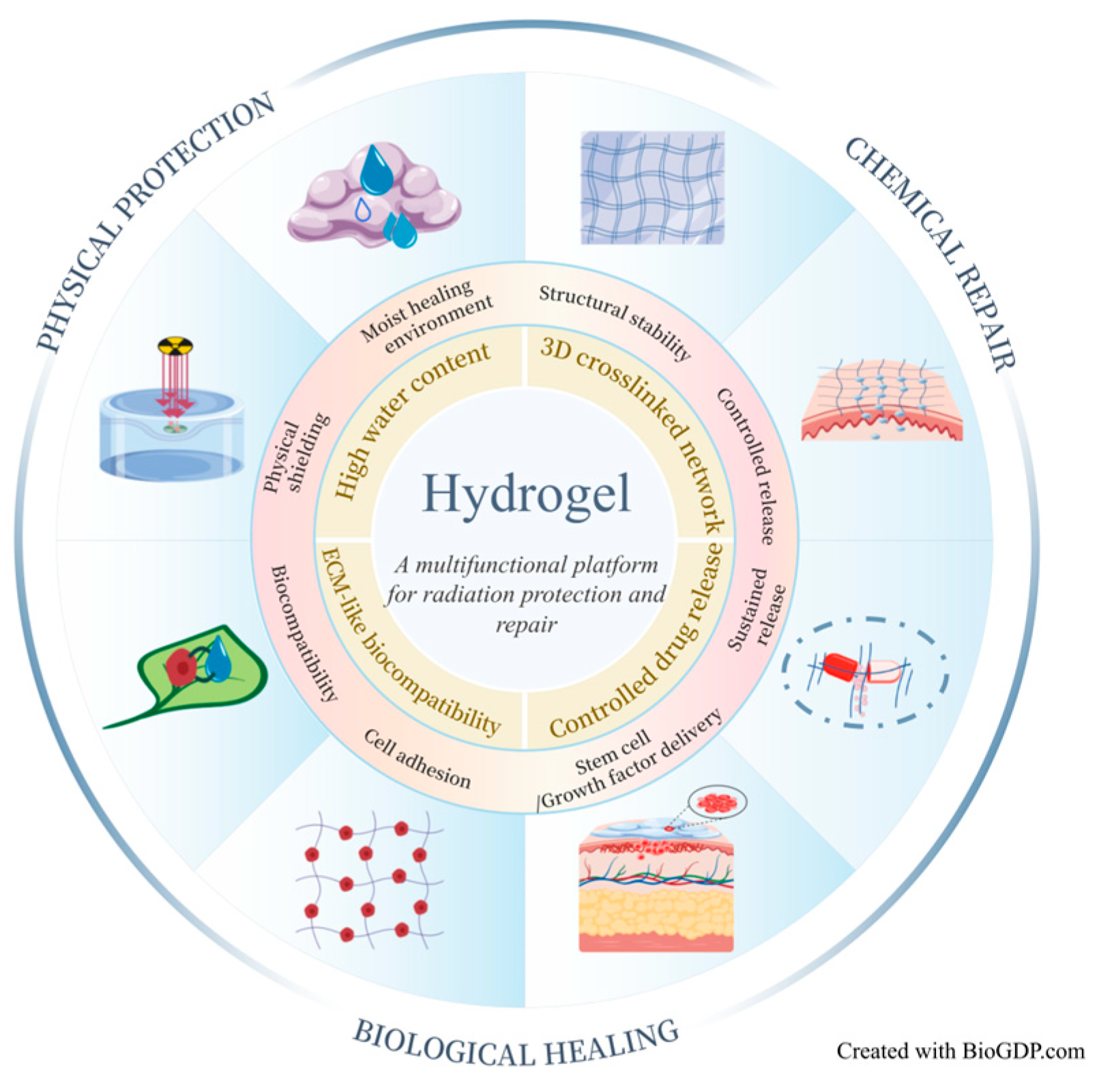
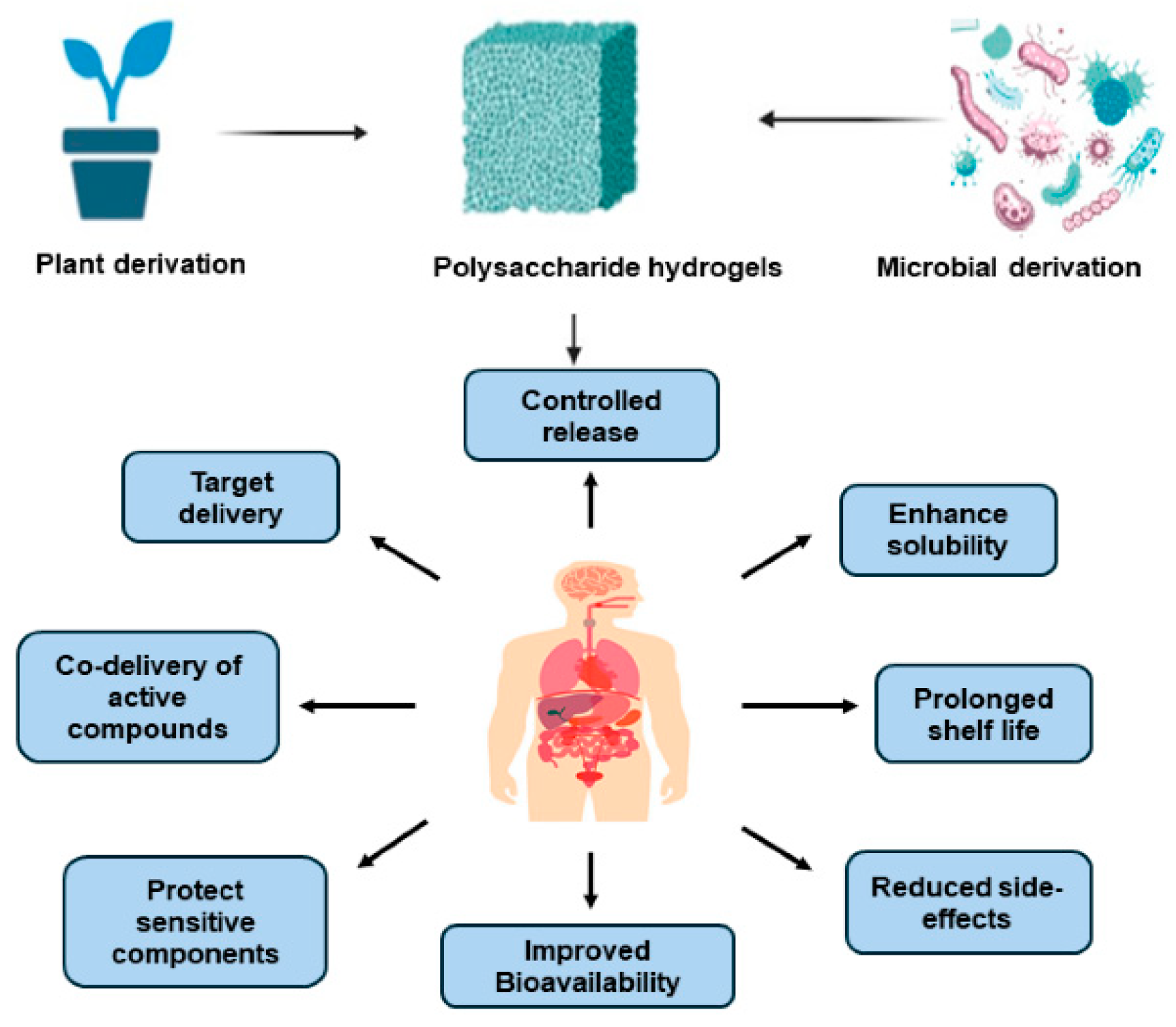
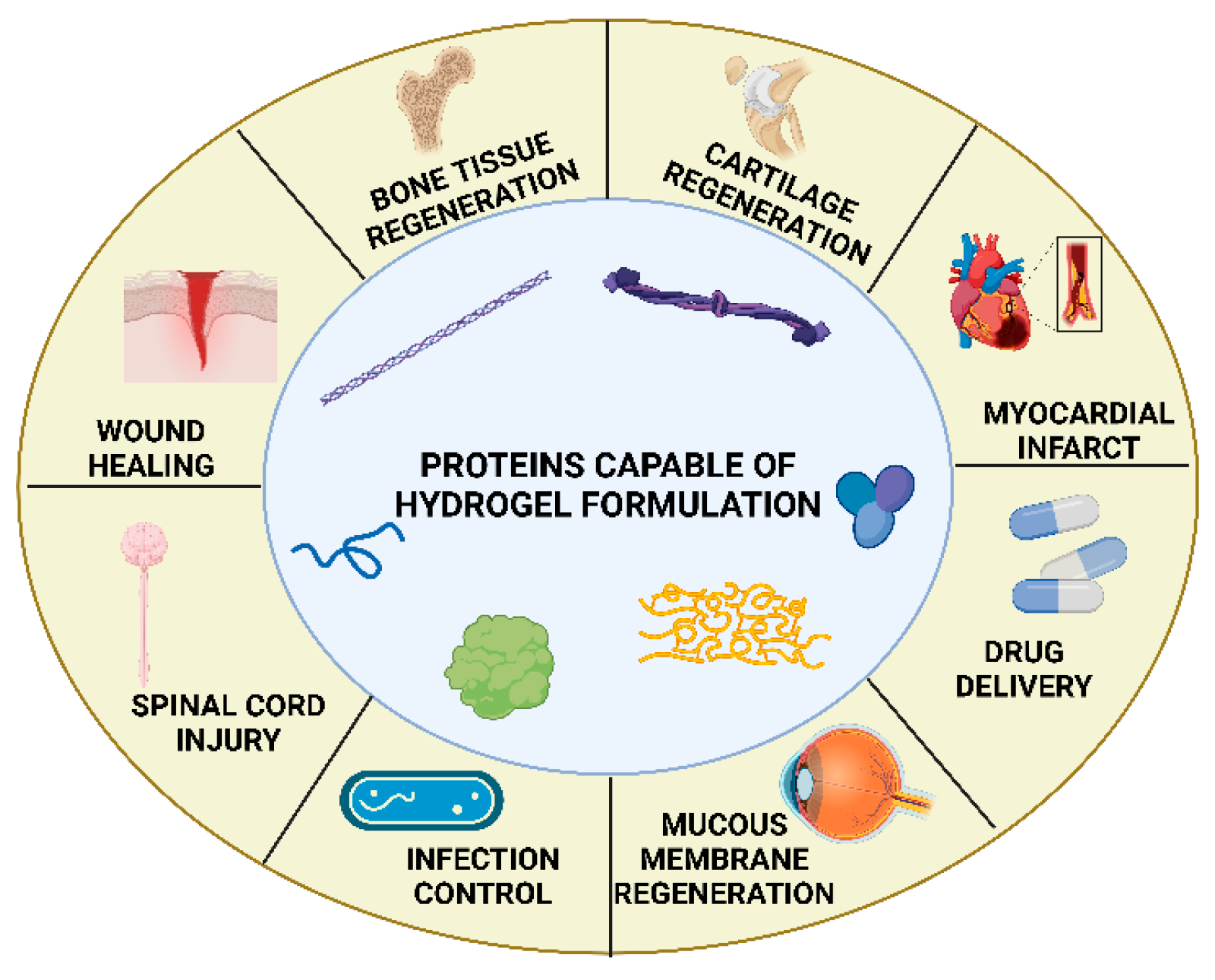

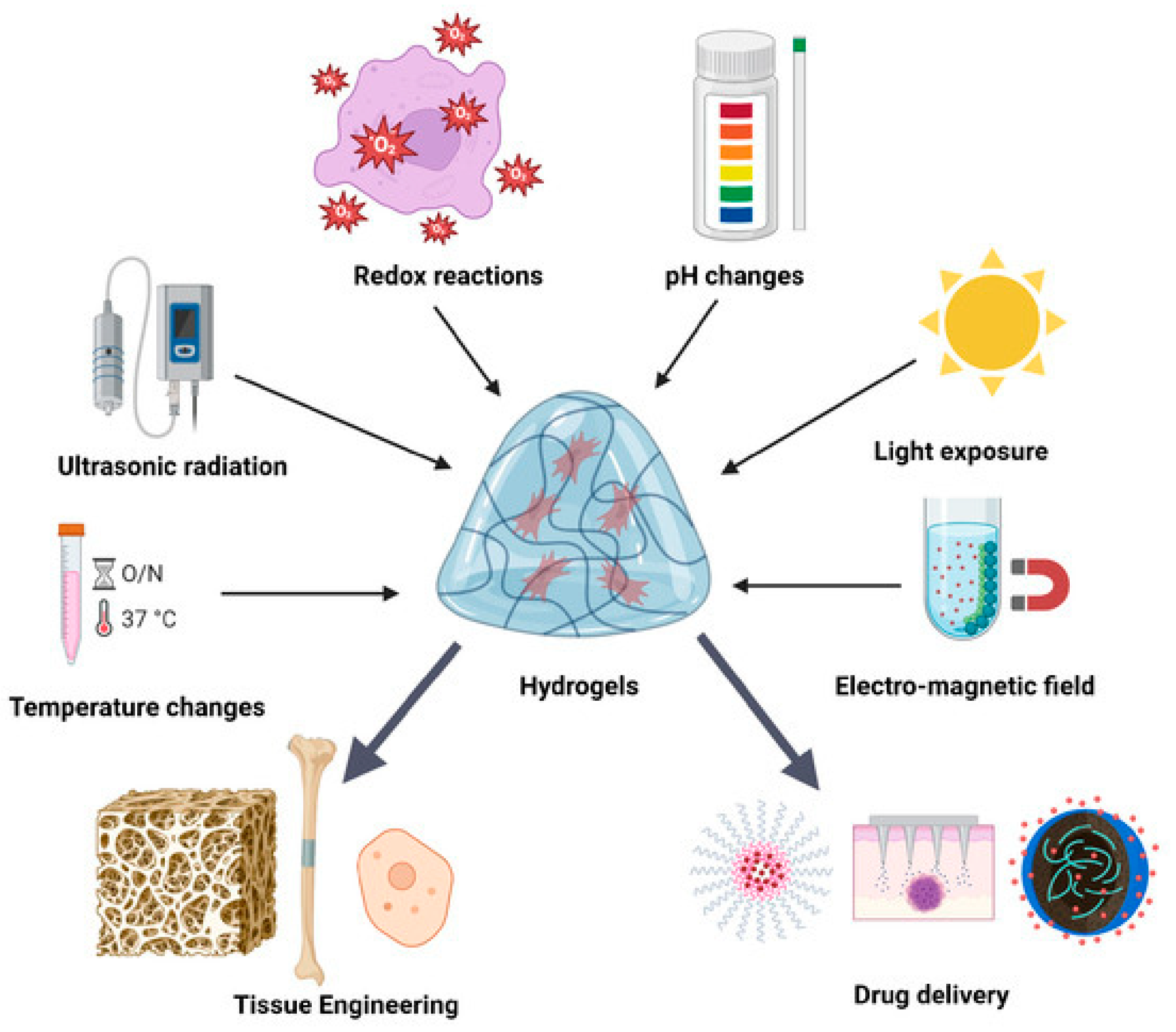
| Type | Representative Drug/Strategy | Advantages | Limitations | References |
|---|---|---|---|---|
| Clinical Experience-Based Treatments | Pentoxifylline |
| Slow onset, requires long-term administration, limited efficacy in the acute phase | [21,22,23] |
| RhEGF |
| Poor stability, short local retention, and relatively high cost | [24,25] | |
| ASCs |
| Complex culture process and high cost, limited clinical translation | [26,27,28] | |
| Topical Corticosteroids (e.g., mometasone furoate, betamethasone) |
| Long-term use damages the skin barrier, recurrence after withdrawal; mainly symptomatic, unable to prevent chronic fibrosis | [29,30,31,32] | |
| Emollients (e.g., triethanolamine cream) |
| Primarily supportive, lacks targeted anti-inflammatory or anti-fibrotic effects; clinical efficacy remains controversial | [33,34,35] | |
| Mechanism-Oriented Protective Strategies | Amifostine |
| Requires intravenous administration, dose-dependent systemic side effects | [36,37] |
| MSCs |
| Limited clinical data, mechanisms not fully elucidated; potential tumorigenic or tumor-protective risks; complex preparation, high cost, and challenges in GMP-compliant manufacturing and safety control | [38,39,40] |
| Representative Material | Molecular/Structural Characteristics | Main Advantages | Key Mechanisms in RISI Repair | Limitations | References |
|---|---|---|---|---|---|
Hyaluronic Acid | A linear glycosaminoglycan composed of D-glucuronic acid and N-acetyl-D-glucosamine. |
| Scavenges ROS and alleviates oxidative stress, Upregulates VEGF expression to promote angiogenesis, Enhances fibroblast and hair follicle stem cell proliferation and differentiation. |
| [60,61,62,63] |
Alginate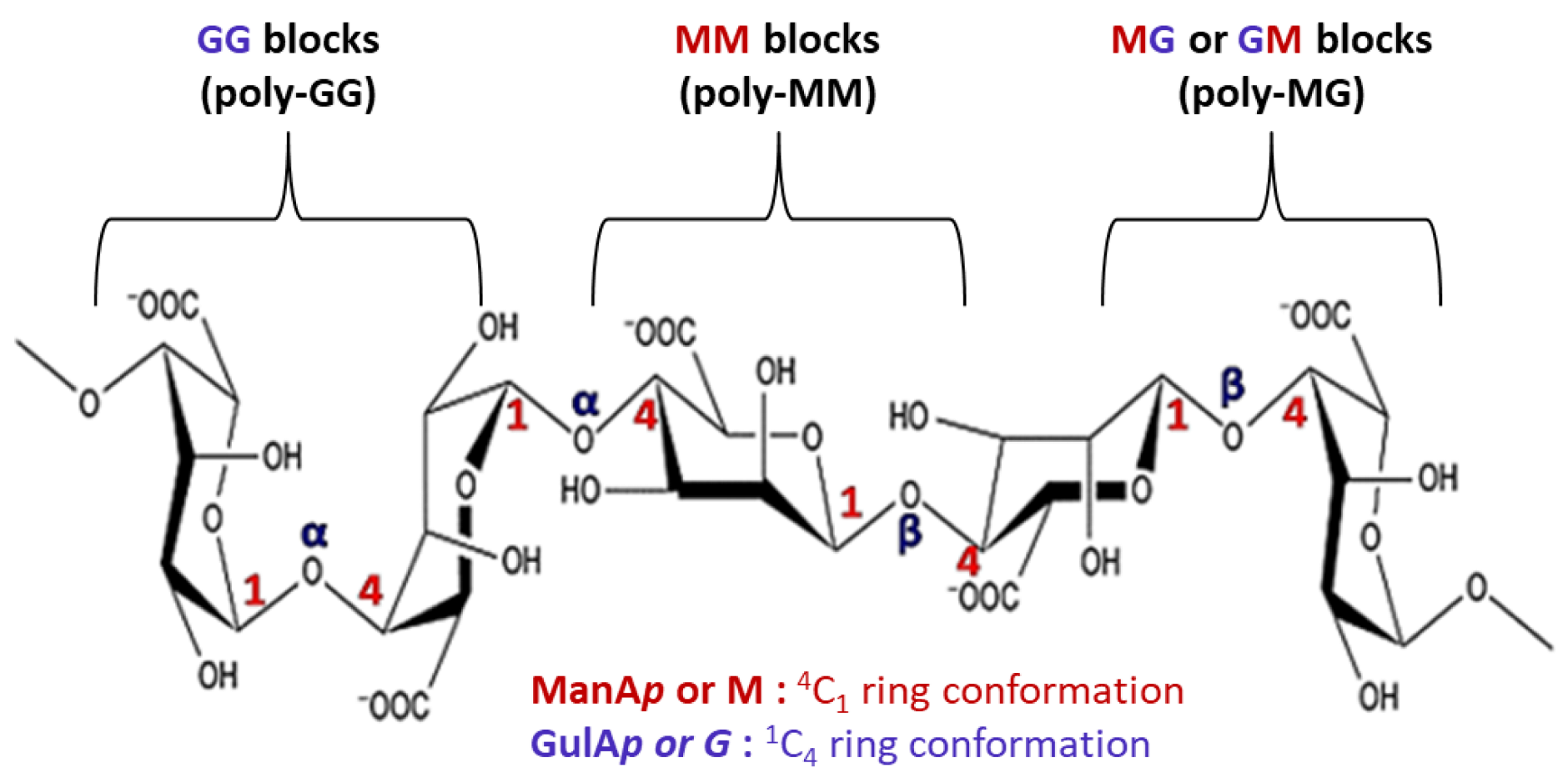 (image adapted from [64]) (image adapted from [64]) | Composed of β-D-mannuronic acid (M) and α-L-guluronic acid (G) residues; cross-links with multivalent cations such as Ca2+ to form gel networks. |
| Ionic cross-linking forms a protective barrier, Scavenges ros and suppresses nlrp3 inflammasome activation, Enhances immune cell activity, Modulates TGF-β1 signaling and fibrosis progression. |
| [65,66,67] |
Chitosan | A cationic polysaccharide composed of β-(1→4)-linked D-glucosamine and N-acetyl-D-glucosamine units with variable deacetylation. |
| Scavenges free radicals, promotes M2 macrophage polarization, inhibits MMP activity via MAPK signaling, facilitates angiogenesis and ECM remodeling. |
| [68,69,70,71,72] |
| Representative Material | Molecular/Structural Characteristics | Main Advantages | Key Mechanisms in RISI Repair | Limitations | References |
|---|---|---|---|---|---|
Gelatin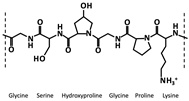 (image adapted from [86]) (image adapted from [86]) | A collagen-derived polymer comprising repeating (Gly–XY) n sequences, where X and Y are typically proline and hydroxyproline. |
| Enhances hemostasis, regulates inflammation, promotes angiogenesis and granulation, and drives collagen type III–I conversion. |
| [87,88,89,90] |
Silk Fibroin | A fibrous protein derived from silkworm silk, rich in Gly/Ala/Ser residues and characterized by β-sheet crystalline domains. |
| When combined with perfluorocarbon emulsions, alleviates hypoxia and promotes cell survival and tissue regeneration. |
| [91,92,93,94] |
Collagen | Predominantly type I and type III collagen composed of Gly–Pro–Hyp repeats forming a triple-helix structure. |
| Enhances antioxidant capacity, reduces ROS accumulation, and promotes sustained anti-inflammatory effects and tissue repair. |
| [95,96,97,98] |
| Material Category | Representative Material | Key Mechanisms in RISI Repair | Main Advantages | Limitations | References |
|---|---|---|---|---|---|
| Decellularized Tissue-Based Materials | ADM | Promotes angiogenesis and M2 macrophage polarization; downregulates IL-1β/IL-6 and upregulates IL-10 |
|
| [39,103,104,105,106] |
| SIS-ECM + hUCB-MSCs | Enhances HGF/VEGF/ANG-1 secretion; accelerates angiogenesis and granulation tissue formation | [107,108,109] | |||
| WJ-MSCs + ECM | Downregulates IFN, TNF, IL-1, and IL-6; upregulates VEGF, EGF, bFGF, and KDR; activates angiogenic pathways; promotes endothelial proliferation and neovascularization. | [110,111,112] |
| Basic Material | Structural/Molecular Features | Main Advantages | Key Mechanisms in RISI Repair | Limitations | References |
|---|---|---|---|---|---|
PVA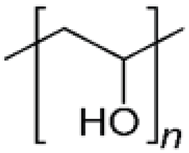 | Linear polyvinyl polymer forming stable hydroxyl–crosslinked networks with polyphenols or polypeptides |
| Scavenges ROS, alleviates DNA damage, modulates immune microenvironment, promotes M2 macrophage polarization. |
| [109,110,111] |
PAA | Linear polymer containing carboxyl groups; forms 3D crosslinked hydrogel networks |
| Scavenges ROS, restores SOD activity, inhibits NLRP3 inflammasome activation, modulates JAK/STAT and PI3K/AKT pathways, enhances fibroblast activation and granulation. |
| [112,113,114,115,116,117] |
PAM | Acrylamide-based polymer crosslinked or copolymerized with functional monomers |
| Removes ROS, reduces inflammation, promotes ECM remodeling and angiogenesis. |
| [118,119,120,121] |
| Functional synthetic peptides (e.g., K16) | Self-assembling heparin-mimicking peptide (KYKYEYEYAGEGDSS-4Sa) forming ECM-like networks |
| Scavenges radiation-induced ROS, suppresses inflammation, promotes angiogenesis and collagen deposition. |
| [108] |
| Composite synthetic polymers (e.g., P-Ac-Lys/PVA-DOPA) | Copolymer hydrogel combining poly(acryloyl-lysine) and PVA-DOPA; capable of loading lactate/pyruvate |
| Pyruvate scavenges ROS; lactate promotes M1→M2 macrophage polarization, improves immune balance, and accelerates tissue repair |
| [118] |
| Type of Hybrid System | Representative Materials/Structural Features | Main Advantages | Key Mechanisms in RISI Repair | Limitations | References |
|---|---|---|---|---|---|
| Cell-Based Hybrids |
|
| Upregulate VEGF, CD31; downregulate IL-6, IL-1β, TNF-α, activate EGFR–STAT3. | Limited cell viability and reproducibility, high batch variability, complex system design. | [123,126] |
| Exosome/Nanoparticle Hybrids |
|
| Scavenges ROS/RNS, upregulates HO-1, CAT, SOD-1,modulates cytokines (↓TNF-α, IL-6; ↑IL-10, TGF-β), promotes angiogenesis, follicle regeneration, and collagen remodeling. | Complex exosome isolation, limited long-term stability and scalability. | [124] |
| Bioactive-Factor/Peptide-Driven Systems |
|
| TGF-β1 promotes ECM synthesis, SP recruits MSCs and activates myofibroblasts, reduces inflammatory infiltration, restores lipid membrane and dermal architecture. | Poor growth-factor stability, uncontrolled release kinetics; potential immunogenicity. | [122,125] |
| Nano/Inorganic Hybrids |
|
| Scavenges ROS, •OH; downregulates IL-6, IL-1β, TNF-α; upregulates VEGF, α-SMA; promotes M2 polarization and angiogenesis; photothermal activation of HSP90, CD31 enhances perfusion | Photothermal response requires external stimuli; limited tissue penetration; complex synthesis; uncertain long-term nanomaterial safety | [127,128,129] |
| Biomimetic/Signal-Regulatory Systems |
|
| Scavenges ROS, repairs DNA breaks via RAD51-mediated homologous recombination; modulates MAPK, Ras, Wnt, TGF-β signaling; promotes angiogenesis and ECM remodeling | Requires high fabrication precision; limited translational validation | [130,131] |
| Type of Responsive System | Representative Material | Structural Characteristics | Main Advantages | Key Mechanisms in RISI Repair | Limitations | References |
|---|---|---|---|---|---|---|
| Acidic Microenvironment-Responsive System | DNAzyme@ZIF-8/TAT hydrogel | DNAzyme encapsulated within ZIF-8 nanocarriers, TAT peptide facilitates cellular penetration and targeted delivery. |
| Acidic ph degrades ZIF-8 to release DNAzyme, Suppresses NLRP3, reduces apoptosis, Promotes HaCaT migration and collagen regeneration. |
| [134] |
| Radiation-Triggered Responsive System | PBAE/HA-MA/AM-EGF hydrogel | Hydrogel network containing disulfide bonds and EGF, irradiation induces bond cleavage and factor release. |
| Radiation cleaves disulfide bonds to release EGF, scavenges ROS, lowers 8-OHdG, promotes fibroblast and keratinocyte proliferation. |
| [135] |
Disclaimer/Publisher’s Note: The statements, opinions and data contained in all publications are solely those of the individual author(s) and contributor(s) and not of MDPI and/or the editor(s). MDPI and/or the editor(s) disclaim responsibility for any injury to people or property resulting from any ideas, methods, instructions or products referred to in the content. |
© 2025 by the authors. Licensee MDPI, Basel, Switzerland. This article is an open access article distributed under the terms and conditions of the Creative Commons Attribution (CC BY) license (https://creativecommons.org/licenses/by/4.0/).
Share and Cite
Wang, Y.; Liu, H.; He, Y.; Li, M.; Gao, J.; Han, Z.; Zhou, J.; Li, J. Hydrogel-Based Strategies for the Prevention and Treatment of Radiation-Induced Skin Injury: Progress and Mechanistic Insights. Biomimetics 2025, 10, 758. https://doi.org/10.3390/biomimetics10110758
Wang Y, Liu H, He Y, Li M, Gao J, Han Z, Zhou J, Li J. Hydrogel-Based Strategies for the Prevention and Treatment of Radiation-Induced Skin Injury: Progress and Mechanistic Insights. Biomimetics. 2025; 10(11):758. https://doi.org/10.3390/biomimetics10110758
Chicago/Turabian StyleWang, Yinhui, Huan Liu, Yushan He, Mei Li, Jie Gao, Zongtai Han, Jiayu Zhou, and Jianguo Li. 2025. "Hydrogel-Based Strategies for the Prevention and Treatment of Radiation-Induced Skin Injury: Progress and Mechanistic Insights" Biomimetics 10, no. 11: 758. https://doi.org/10.3390/biomimetics10110758
APA StyleWang, Y., Liu, H., He, Y., Li, M., Gao, J., Han, Z., Zhou, J., & Li, J. (2025). Hydrogel-Based Strategies for the Prevention and Treatment of Radiation-Induced Skin Injury: Progress and Mechanistic Insights. Biomimetics, 10(11), 758. https://doi.org/10.3390/biomimetics10110758







